Degenesis: Rebirth Edition – The Review
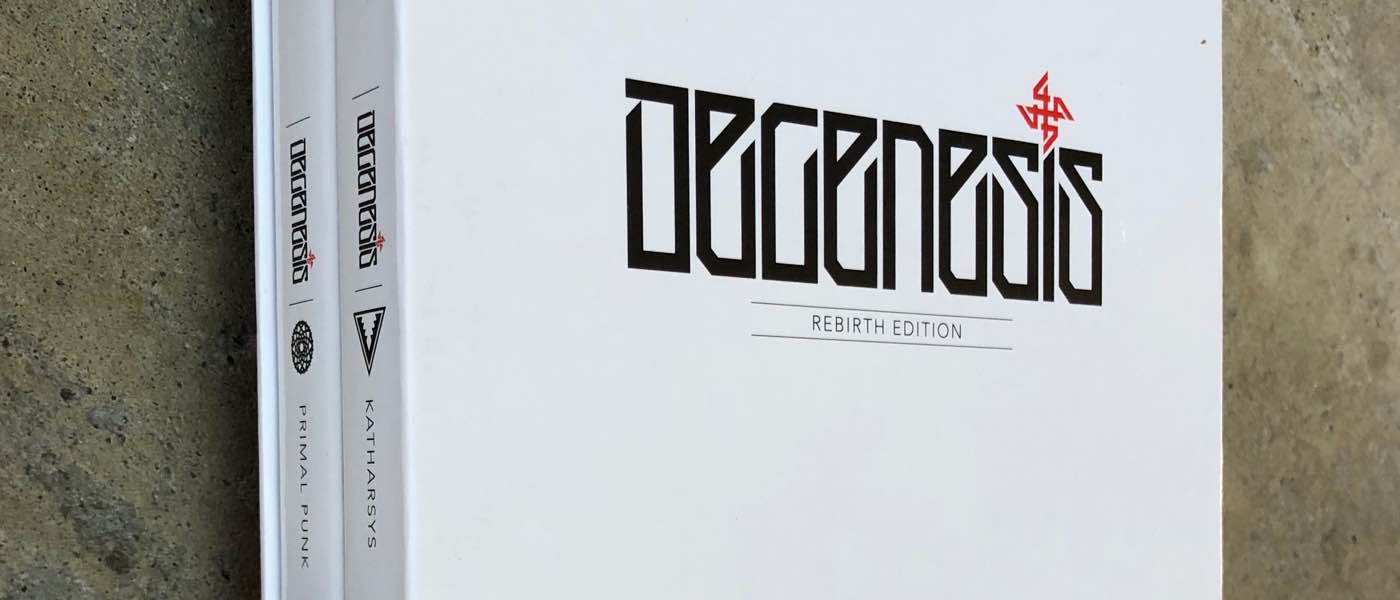
TL;DR
Degenesis: Rebirth is a visually astounding, sumptuous, two-volume, 704-page passion project — a richly-layered, horrific, intrigue-riddled, techno-mystical post-apocalypse Earth that feels like it was discovered rather than created. This is truly a game for players who enjoy being immersed in a deep, artfully-revealed setting. If you are looking for flashy system innovation you’ll have to look elsewhere, but the straightforward KatharSys mechanics incorporate some clever touches and are well-suited to the tone of the game. Read on for more details.

Context for This Review
What is life like for player characters, what is their place in society, and what are the complexities of their culture? What is going on around them, and how does their place in the world influence their actions?
For some role-players those questions aren’t terribly important, falling into the category of fluff. For me as a game master and as a player exploring those questions is one of the primary joys of roleplaying. So I tend to gravitate toward games that feature dense, complex settings. The worlds of Glorantha and Eclipse Phase, for example, are near and dear to my heart because of their originality and breadth, as well as the way they weld seemingly disparate elements into an immersive whole.
I say all this because it’s important for you to know my biases. There is no such thing as a neutral review of a creative work, whether it be of a novel, a movie, or a tabletop RPG. And you should know up front where I’m coming from when I say Degenesis: Rebirth is one of the most impressive games I’ve ever encountered.
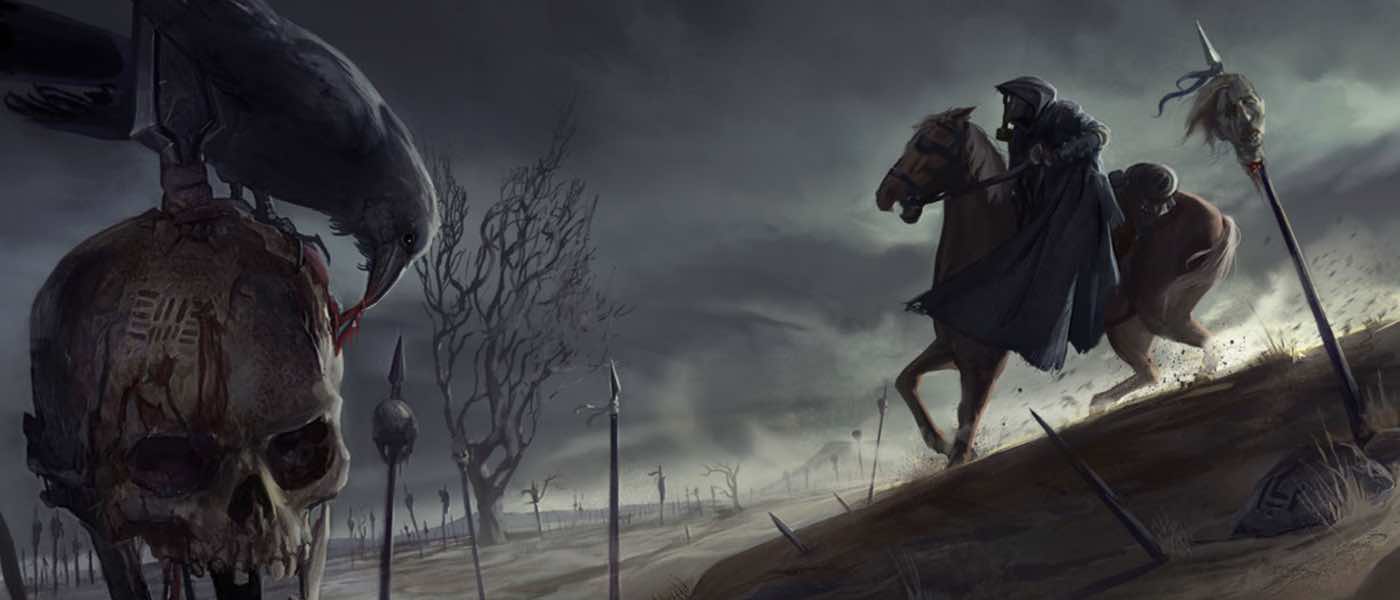
The End of the Beginning
The world of Degenesis is revealed through gorgeous illustrations, vibrant two-page spreads, bold maps, stunning layout, and voluminous, sometimes oblique text. This is not a setting meant to be easily mastered. You don’t read straight through it — you explore, skimming from section to section. You dip into the spore fields of Franka, then absorb the strange wonders of the Anubians before careening off to the lush splendors of Tripoli or the horrors of the Psychokinetics.
Degenesis is set not in the wide-open deserts of Australia or the vast wasteland of a blasted America, but in the lands surrounding the Mediterranean. This is Europe and northern Africa hundreds of years after the apocalypse, a moment when civilization has rebounded but faces a relentless threat.
There are no irradiated mutants in Degenesis. It was a meteor strike that delivered the Eschaton, the end of the old world and the beginning of the new. The meteors tore into the landscape and brought a horrifying alien biology with them — the Primer, foundation of a host of terrors. Massive spore fields now cover the land, and the humans they infect become Homo Degenesis — warped, powerful, and supremely confident that Earth is their dominion.
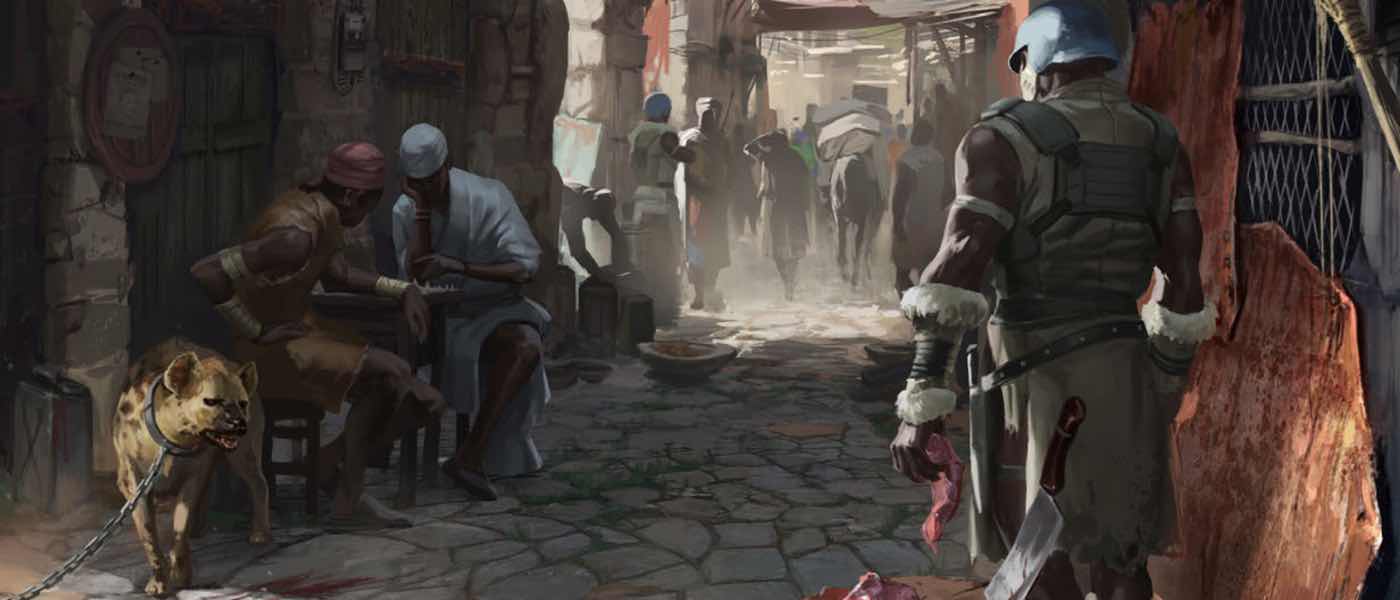
Cultures
Civilization is spread across several Cultures that have risen from the remnants of the old world:
- In the the frozen tundra of Pollen, hardy wanderers trek from one cold oasis to another, defending themselves from Psychonauts and strangers alike.
- Borca , cut in two by the massive meteor impact known as the Reaper’s Blow, is home to the thriving metropolis of Justitian and its rules-bound Protectorate.
- Haunted by the Dushani, Balkhan is a land where the power of the Cults is weak, and fighting is a way of life.
- Franka is dominated by swamps and spore fields. Pheromancers work to overwhelm the land with their insect legions.
- In Purgare family is everything. The home of the Anabaptists is also where Psychokinetics have risen to take on humanity.
- Hybrispania seethes with rebellion against the occupying Africans. Pregnoctics are welcomed as oracles, and Guerreros fight for freedom.
- The Eschaton led to a literal flowering of Africa and concurrent rise to economic and military dominance. Tripoli, with its powerful Bank of Commerce, is the hub of the world.
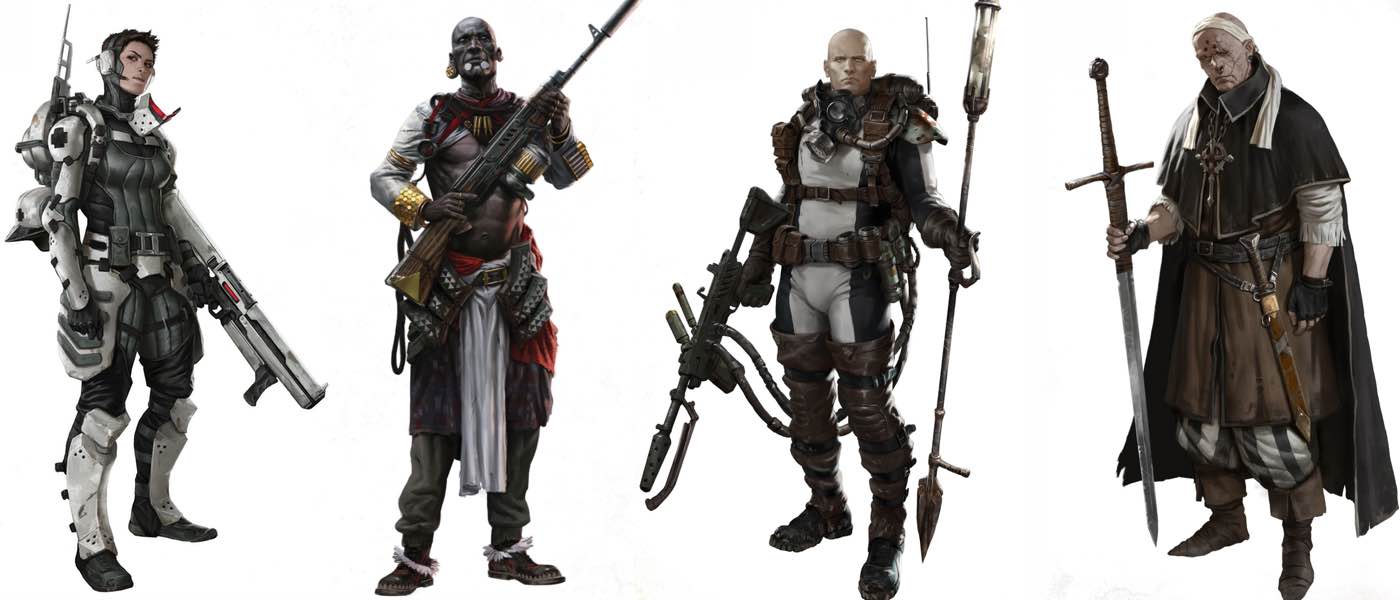
Cults and Clans
Across the land Cults carry out their own mysterious plans, each seeking to create a better world in their own fashion. Each approaches the Primer invasion differently. The Cults engage in convoluted stratagems against each other, form alliances where necessary, and stay vigilant against the smaller but often dangerous Clans that pursue their own goals.
- The rigid Spitalians fight to cleanse the earth of the Primer and its ilk.
- Information is power, and the secretive Chroniclers gather and trade it.
- Hellvetics are an austere army without a country, controlling passage through the Alps and hiring out to those who need their expertise.
- Judges enforce laws within the Protectorate, sometimes in Justitian’s Hall of Justice, sometimes with the swing of an iron hammer.
- Scrappers sift through scrap, delve into the remains of ancient ruins, and bring back lost technology and some of the knowledge that created it.
- Neolybians establish trade routes, explore the edges of maps, and seek to bring about the kind of order that leads to profits.
- Scourgers are ever-vigilant warriors, the strength that undergirds the African empire.
- Keepers of secrets, the Anubians mystics undergo physical transformations as they gain deeper understanding of both life and death.
- The Apocalpytics move in flocks where whim takes them, living with passion, recklessly in the moment, knowing every day might be their last.
- Jehammedans serve God, shepherding their families and hewing to a strict faith.
- Anabaptists fight to defeat the Demiurge and prove that humanity is worthy of God.
- Memetically-programmed Palers guard the divine Sleepers, cryonauts who are awakened in waves to guide the world according a plan laid out before the old world died.
- Though the Cults hold more power, the Clanners are numerous and bow down to no one.
What the Primer Hath Wrought
Primer forms the building blocks of a takeover of Earth biology. Microscopic spores infect living things, birthing all manner of twisted horrors, from Rift Centipedes to Acid Jellyfish. Sepsis burrows deep into the soil, giving rise to massive Mother Spore Fields that can stretch for kilometers. The Mother Spores contain Burn, a powerful drug. When ingested it takes over its host, turning that person into a Leperos, a walking spore infestation.
Human children born infected by Mother Spore Fields become Psychonauts (also known as Abberants). Depending on which Spore Field infected them, they will mutate into one of several different kinds of Homo Degenesis:
- Biokinetics come from the Spore Fields of Pollen, can control arachnid and insect swarms, and employ horrific powers.
- Dushani control creatures of the deep and dark. They have spread from Balkhan and use their sonic abilities to manipulate minds.
- From Franka the Pheromancers have spread, using powerful pheromones to captivate humans and bring them into a web of blissful stupor. They can control ants, wasps ad other hive insects.
- The Pregnoctics share their visions of the future with the Hybrispaniards and control ancient creatures such as starfish, urchins, and trilobites.
- Bloated, corpulent Psychokinetics manipulate energy in a variety of fearsome ways. They can control parasites – fleas, leeches, tapeworms, and the like.

Technology
Memetics. The Stream. Cryogenics. Nanotechnolgy. Machine Men. In Degenesis a panoply of pre-Eschaton technology is commingled with resurrected machinery, scrap-manufactured gear, and post-Eschaton constructs. Sometimes the ancient technology is obvious, for example the Surge Tanks that roll into a town and enforce Scourger dominion. At other times it’s hidden — the memetics that program waves of Sleepers, or the nanites that strengthen the blood of an exalted few.
The rules provide information on a wide array of weapons, from stones and slings to submachineguns to Soul Burner rifles. Adventuring gear, transportation, medicines, and other items are also covered. Degenesis includes rules for combing through scrap, manufacturing new items, and modifying weapons and other gear for improved performance.
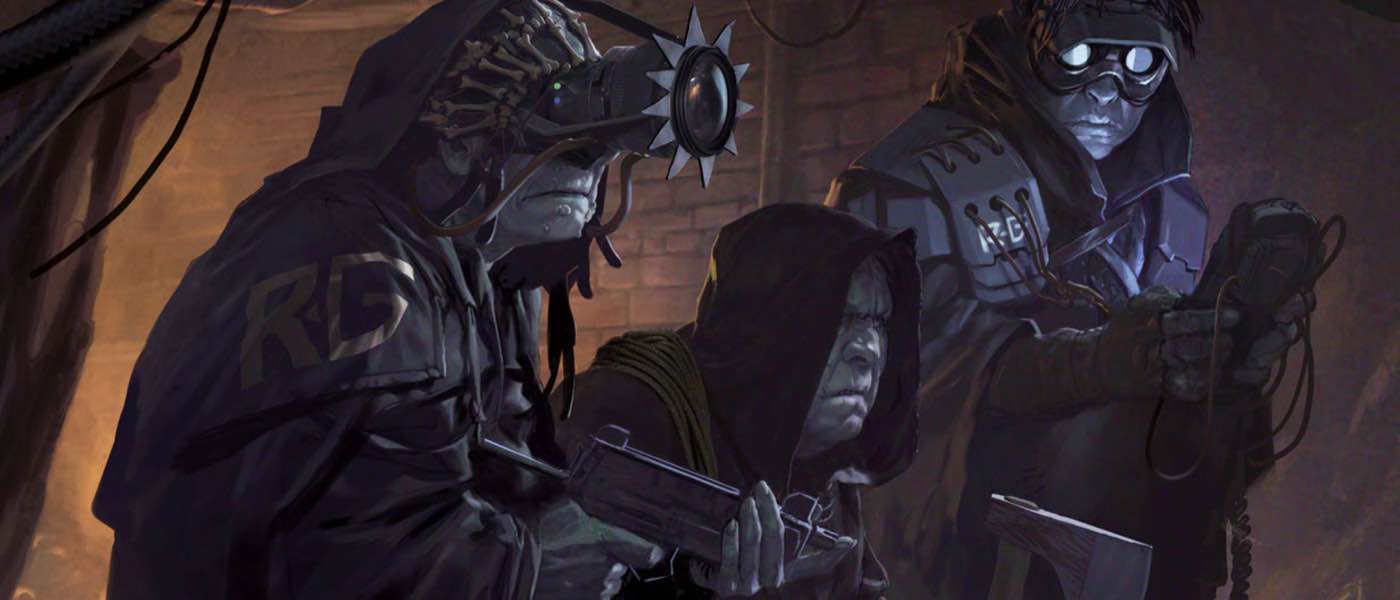
Conflict
Post-apocalypse games often concern themselves primarily with survival, scouring the ruins of the old world for technological advantage, and building a new civilization. While these goals can make for engrossing game play, it can be difficult for even the most experienced game master to turn them into a lengthy, compelling campaign.
Degenesis deftly avoids this trap by placing the Primer at the core of the game. It’s alien, relentless, a force rather than a being or even an ideology. It shifts, it changes, it gives rise to new horrors. How characters see themselves in relation to this alien invasion defines a campaign.
Orbiting closely around that central conflict are the machinations of the Cults, of which player characters are members. Regardless of their goals, characters will have to maneuver through complex inter-Cult politics as they pursue their own goals. This is not a game of good versus evil. There are no Cults without blood on their hands. That said, PCs in Degenesis are not rootless murder hobos. They are tied to Culture and Cult. Called upon to make difficult choices, what they do tangibly affects their reputation and standing within their Cult and with others.
So what do player characters do in Degenesis? What sorts of adventures can GMs build for them? Here are a few examples:
- PCs can engage in investigations. This a world rife with conspiracies and secrets, and knowledge about what’s really going on can be immensely valuable.
- They can work to further the cause of their Cults, keeping others from gaining the upper hand.
- Psychonauts threaten to overwhelm humanity. PCs can use their wits and skill to thwart the goals of these enormously powerful foes, and perhaps eventually confront them directly.
- They can fight for the cause of independence or to strengthen centralized control, be it from Tripoli or Justitian.
- Keeping disagreements between Cults from turning into serious conflicts requires a unique combination of unbending determination and diplomatic flexibility.
- Many areas have long been abandoned to the Spores. But what if some of them hold resources that could be useful in fighting the Primer?
- Before Eschaton, humanity wielded great power. Hunting for artifacts from the lost past is dangerous but potentially very rewarding.
As a GM one of the things I look for in a game world is hooks I can use to create my own adventures. Tidbits of information, notes about hidden conflicts, scraps, hints, references to fragments of ideas – these are the things that ignite my imagination and help me prepare to run a campaign. Degenesis provides over a dozen enticing story hooks that can be used individually or combined to build adventures. Throughout the books there are also liberal sprinklings of ideas for people, themes, items, locations, and events.
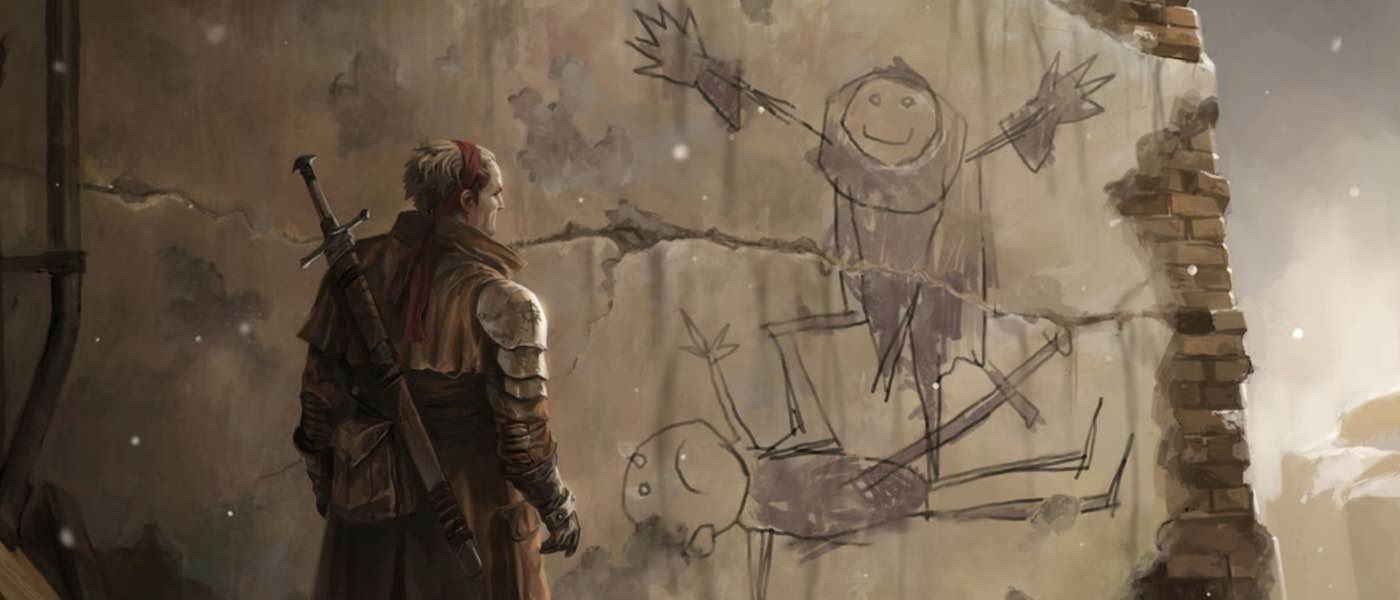
KatharSys and Characters
While the first volume of Degenesis: Rebirth is purposely diffuse, the second book lays out the KatharSys game mechanics in a much more straightforward fashion. KatharSys is built around a d6 dice pool mechanic:
- The number of dice rolled is equal to the point value for the Attribute that covers the action, and the point value for the Skill that applies to the action.
- Any important action is assigned a Difficulty number by the game master.
- A roll of 4 or higher is a success.
- Roll a number of successes equal to or higher than the Difficulty number, and you accomplish the action.
- Every roll of 6 is a Trigger, with multiple Triggers creating more impressive outcomes.
- Roll more 1s than successes and you Botch. Botches are as you might suspect, even worse than simply failing.
Characters are defined by their Attributes (Body, Agility, Charisma, Intellect, Psyche, and Instinct), and Skills, each of which is associated with a particular Attribute (Ex: Stealth is tied to Agility). Players build characters by assigning points to Attributes and Skills from a starting pool.
The character’s Culture and Cult increase particular Attribute and Skill maximums. For example, coming from the African Culture, the character Khari would receive +1 maximum to Intellect and Body, and +1 maximum to the Athletics, Brawl, Expression, Medicine, and Reaction Skills. Selecting the Scourger Cult gives him +1 maximum to Athletics, Force, Mobility, Stamina, and Reaction. These modifiers are additive.
Two skills, Primal and Focus, are mutually exclusive, and are indicative of how a character approaches problems. Primal is tied to Instinct, while Focus is tied to Intellect. The same is true of Faith and Willpower, though both are tied to the Psyche Attribute.
Every character also has a Concept, which is a statement about the character’s motivations that also provides mechanical benefits. If Khari is given The Traditionalist as his Concept, he receives a +1 maximum to the Instinct Attribute and to his Legends and Conduct skills.
Each character starts at Rank 1 within their Cult, but can move up in Rank during character creation. Cult Ranks are important not just because of the benefits they provide to characters, but also because Ranks fulfill specific roles within a Cult. Sometimes a Cult structure provides for two different Ranks at the same level. For example, a Rank 2 Scourger could be either a Hondo, an intimidating warrior, or a Damu, a shrewd scout.
Characters also have access to Potentials, which can be either Common (accessible to anyone) or Cult-specific. These are legendary maneuvers, extraordinary special skills, and feats of Willpower or Faith. Each character starts with one Potential at Rank 1. Here’s a Common Potential that would be appropriate for a Scourger:
Unyielding: What is the mind but a muscle that can be steeled through vehemence and inner peace? The Character can counter a mental attack by an effort of will once per conflict and gets +1D per Potential level when doing so.
There’s a bit more to it, but these are the basics of character-building. After filling in a few more details and gearing up, your character is ready to go. But be wary as you go out into the world of Degenesis. Combat is deadly and healing from serious wounds can take weeks. As the book puts it:
Characters advance by way of Experience Points, which are earned for accomplishing goals and surviving difficult situations. XP can be used to improve Attributes and Skills. This eventually leads to increased Cult Rank and with it increased responsibilities as well as access to greater resources.

Building a Campaign
The game mastering section of Degenesis is a useful collection of ideas and suggestions to help get a campaign rolling. In a world as expansive as Degenesis it can be difficult to think of a starting point. But the suggested technique for mixing themes, people, locations, items, and events is a good one.
From the short idea lists provided, a game master can come up with a number of quick adventure outlines. For example: A Hybrispanian slave has escaped a brutal Neolibyan slaver and found his way to an ancient fortress where Khari and his Scourger compatriots are conducting a training mission. Khari is duty-bound to take the slave back. As a Traditionalist he believes he must return the slave. But his closest colleague is set against this path. Sekai the Scrapper is a Protector, and she knows what will happen to the slave should he be returned. To make matters worse, the locals have had enough, and a band of Guerreros are heading to the fortress to free the slave, by force if necessary.
It’s useful to think about the interaction of Cults when assembling an adventuring group. In some game worlds factional affiliation is almost ornamental, but in Degenesis it’s extremely important. So for example an Anubian, a Jehammedan, and an Anabaptist could all be found in the same group, but there needs to be a strong, believable reason why members of three Cults that often find each other at odds would be together.
Degenesis includes an adventure, Embargo, that can be placed with minimal modification in a variety of locales. In published Degenesis adventures there is always a story, and the world is always in motion. The backstory, motivation, and actions of NPCs are examined in detail. These characters are not just waiting for the PCs to show up; they’re busy pursuing their own goals. The adventure is written essentially as a linear narrative with predefined scenes.
To date Sixmorevodka has published three primary supplements: In Thy Blood, The Killing Game, and Black Atlantic. Each incorporates a meticulously-detailed adventure and serves as a guide to a particular region, with information about the geography, factions, and key NPCs in the area. Taken together, they also lay out a densely-woven metaplot that stretches across all three books. These adventures follow the same underlying structure as Embargo — the PCs are essentially along for the ride.
As a GM you’ll have to decide up front how you want to engage with these adventures and the larger metaplot. The locales and NPCs are complex and compelling, and the metaplot is tremendously inventive and engaging. There are also countless hooks a GM can use to weave in their own adventures. But while the material in the adventures can be quite helpful, playing them straight through as written won’t work. Active, engaged players will feel railroaded if you do. So the best approach is probably the one advised by Erwan Roudaut in The Codex, his useful collection of Degenesis tips:
The metaplot should be used like a spice. You use it to give a little extra something to your campaign and make it a bit more exciting at some points. However, don’t use it as the core ingredient of your story, or you will probably miss it entirely.
This isn’t meant to dismiss the supplements. I’ve read them all, and they’re gorgeously-produced, the maps and art at times even exceed what’s in the core books. Each features a wealth of detail, from geography to NPCs to secrets about the inner workings of the world. Black Atlantic in particular provides a dizzying quantity of material.

Adult Themes
One of the things that most clearly distinguishes Degenesis from most other post-apocalypse games is its treatment of mysticism and religion. In Degenesis the old religions were not eradicated, nor were they replaced by the tired trope of worship of the ancients. Instead they were reborn as new faiths. This reworking provides thoughtful players a way to engage with questions of belief. It also provides a useful counterpoint to the horrors of the Primer.
Degenesis evidences a European sensibility about sexuality. That said, this isn’t a game about sex; it’s a game that doesn’t avoid it. Out of dozens of character portraits in the core books, there are a few images featuring half-naked men and women, and a handful showing full nudity.
Because this is a game that takes place in our world, no matter how far in the future or how fantastical, the authors placed a disclaimer at the front matter of both of the core books:
Degenesis advocates tolerance and international understanding. The game world of Degenesis has evolved from ours and distorts it into an imaginary future. Conflicts within the game world are, of course, not real – and we do not wish for them to be, either. They only exist for excitement’s sake. Although we know this kind of conflict from films, we urge you to use them with caution. None of the seven Cultures mentioned in Degenesis is better than any of the others. All of those Cultures have an equal right to exist in the game world of Degenesis.
We have actively avoided the term “race” common to RPGs as we deem it discriminatory.
We strictly oppose violence and racism. Illustrations of combat action are not meant to promote violence, but to depict a cruel world we should strive to overcome. Culture and civilization are the major goals in Degenesis, accompanied by hope. We still recommend Degenesis for people 16+ as we cannot be sure whether our message and our appeal to humanity will be understood.
The game fuses dozens of cultures into seven post-Eschaton Cultures. This merging and mixing feels right. It evokes echoes of cultures we know now without being bound by them. It also keeps the number of Cultures manageable for a GM.
One aspect of the game’s treatment of cultures also deserves special attention. Degenesis is the first post-apocalypse game I’ve encountered that didn’t either ignore Africa, use the continent merely as a battleground for European and American combatants, or declare it wiped out by the ruin. Geography is destiny, and the changes wrought by the Eschaton favored Africa over Europe. Africa flourishes; it represents political power, military dominance, and abundance. Like the empires of the past, its influence is either benign or malignant depending on who you are. Several African characters play pre-eminent roles in the metaplot, and the African Culture is presented with nuance and complexity.
Degenesis Online
- The Sixmorevodka Degenesis website is full of images and info about the game
- Actual play videos
- The official forum [2022-10-16 The official forum is no longer active]
- Degenesis on Facebook
Buying Degenesis
Degenesis: Rebirth is published by Sixmorevodka, a Berlin-based boutique art studio that does work for the video game and film industries. Much of the company’s output is produced under non-disclosure agreements. So part of the rationale for Sixmorevodka lavishing so much attention on the latest incarnation of Degenesis is to demonstrate the company’s world building, character development, and story design capabilities. If you haven’t already, check out these two Degenesis videos, which demonstrate the lengths Sixmorevodka has gone beyond the printed page:
Sixmorevodka publishes the core books and several supplements in both print and PDF. The printed books are of uniformly high quality, printed on heavy paper and perfect-bound with marker ribbons. The PDFs are provided in print and screen resolutions. They’re searchable but are only hyperlinked from the table of contents. The supplements are, in metaplot sequence:
- In Thy Blood (Set in Purgare) — 104 pp
- The Killing Game (Set in Southern Franka) — 208 pp
- Clans of the Rhône (Clans found in Southern Franka) — PDF only, 22 pp
- Rising Ravens (Bridge between The Killing Game and Black Atlantic) — PDF only, 24 pp
- Black Atlantic (Set in Briton) – 278 pp
Additional game aids:
- GM Screen — Thick 4-panel (2 varieties – Homo Sapiens and Homo Degenesis)
- Cult Cards — 13 oversized cards used for tracking player character relationships with other cults
All of the above can be purchased at the Sixmorevodka webshop. They’re also carried by some game stores. I ordered In Thy Blood, The Killing Game, and the GM Screen from Alpha Omega Hobby.
Ω
2021-03-29: I recently started a blog devoted purely to Degenesis. Check it out: Train to Baikonur.
